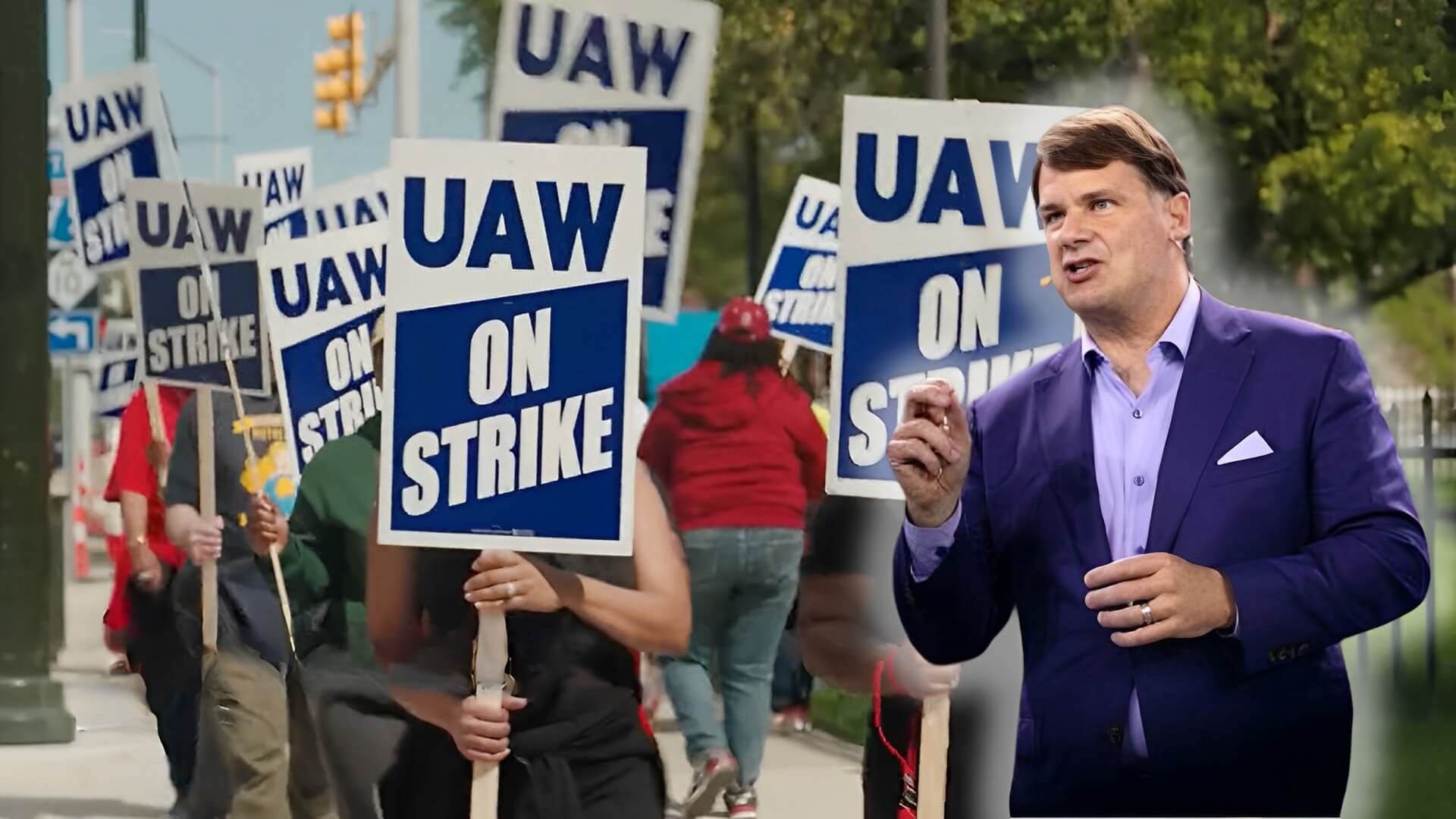The United Auto Workers (UAW) union has recently initiated a strike that marks a historic moment for the American auto industry. For the first time, the union is taking collective action against all three major American automakers – Ford, General Motors, and Stellantis simultaneously. This unprecedented move has far-reaching implications, not just for the companies and their employees, but also for the broader auto industry, including the burgeoning electric vehicle sector.
Let’s have a comprehensive overview of the ongoing UAW strike, its underlying causes, its economic impact, and what it means for the future of transportation in the United States.

UAW Strike 2023: An Unprecedented Move
The UAW strike is a watershed moment in American labor history, with the potential to redefine labor relations in the auto industry for years to come. The stakes are high, and as the strike unfolds, its impact will be felt not just by the workers and the companies involved, but by the entire American economy.
Historical Context
The UAW has been a cornerstone of the American auto industry for decades. However, the current strike represents an unprecedented move in the union’s history. The collective action against automakers signals a significant escalation in labor disputes and sets a new precedent for future negotiations.
Current Numbers
As of now, approximately 12,700 workers have walked off the job, affecting one plant for each of the three major automakers. While this number may seem substantial, it’s just the tip of the iceberg. If the automakers fail to reach a satisfactory agreement with the union, the strike has the potential to escalate, involving up to 146,000 UAW workers across the United States. This would not only cripple the auto industry but also have a ripple effect on related sectors and the broader economy.
Targeted Plants
The strike is currently focused on three specific plants:
- GM’s Wentzville Assembly in Missouri: This plant primarily produces trucks and vans, including the Chevrolet Colorado and GMC Canyon.
- Ford’s Michigan Assembly in Wayne, MI: Known for producing the Ford Ranger and Bronco, this plant has also been affected by layoffs, as mentioned in a recent tweet about Ford laying off 600 employees due to the strike.
Here is the official announcement that Ford is laying off 600 employees at its Michigan assembly plant. This is due to issues related to the strike. pic.twitter.com/bSRok44TnW
— Sawyer Merritt (@SawyerMerritt) September 15, 2023
- Stellantis’ Toledo Assembly Complex in Ohio: This plant is unique in that it currently produces an electrified vehicle, the Jeep Wrangler 4xe, a plug-in hybrid.
The targeting of these plants is strategic, affecting a range of products and potentially hitting the automakers where it hurts the most profitability and production capabilities.
Why Is UAW on Strike?
The stand-up strike is a calculated move to gradually increase pressure on the automakers. It serves as a warning that the union is prepared to escalate the strike to include more plants and workers if the companies do not meet their demands.
UAW’s Arguments for Better Wages, Benefits, and Pensions
The core issue driving the UAW strike is the perceived imbalance between the workers’ compensation and the automakers’ profits. The union argues that despite record-breaking profits in recent years, the benefits have not trickled down to the workforce. Workers are demanding higher wages, better healthcare benefits, and the reinstatement or improvement of traditional pension plans, which have been eroded or replaced by 401(k) plans in many cases.
Comparison of Corporate Profits vs. Worker Benefits
The disparity becomes even more glaring when you look at the numbers. According to the UAW, profits and executive pay in the auto industry have surged by 65% and 40%, respectively, over the last four years. In stark contrast, autoworker pay has risen by a mere 6%. This significant gap highlights the union’s argument that workers are not receiving their fair share of the profits they help generate.
UAW New Leadership, New Tactics
The UAW strike is fueled by longstanding grievances over wage and benefit disparities, now amplified by new leadership and innovative tactics. As negotiations continue, these strategies could play a pivotal role in shaping the future of labor relations in the American auto industry.
Introduction to UAW’s New President, Shawn Fain
The UAW is under new leadership, with Shawn Fain taking the helm as the union’s president. Fain was elected in the first direct election in the UAW’s 88-year history, signaling a new era of transparency and accountability. His leadership comes at a crucial time as the union grapples with significant challenges, including this landmark strike.
Explanation of the “Stand-Up Strike” Strategy
Under Fain’s leadership, the UAW has adopted a new tactic known as the “stand-up strike.” Unlike traditional strikes that target a single automaker or plant, the stand-up strike involves shutting down a few plants across all three major automakers. This strategy serves a dual purpose: it shows that the union is serious about its demands while also allowing the UAW’s strike funds to last longer. With around $825 million earmarked for strike funds, the union can financially support its workers for an extended period.
UAW Strike Impact on the Economy and Auto Industry
The strike could also affect international operations. Many American automakers have global supply chains, and a prolonged strike could lead to production halts in other countries, further amplifying the economic impact.
Estimated Cost to the U.S. Economy
The UAW strike is not just a labor dispute confined to the auto industry, it has broader economic implications as well. According to estimates, a 10-day strike could cost the U.S. economy as much as $5 billion. This figure takes into account not only the lost production and wages but also the ripple effects on related industries, from parts suppliers to logistics companies.
Impact on the Supply Chain
The auto industry operates within an intricate supply chain that involves numerous suppliers, manufacturers, and distributors. Even a short-term strike can disrupt this delicate ecosystem. For instance, if assembly plants are not operational, there’s no need for parts like windshields, tires, or electronic components. This can lead to temporary shutdowns or reduced operations at supplier factories, affecting employment and revenues in those sectors as well.
Moreover, the strike’s impact on the supply chain can have a domino effect on other industries. For example, transportation companies that rely on delivering auto parts may experience a decline in business. Retailers selling new cars could face inventory shortages, leading to lost sales and reduced commissions for sales staff.
Impact on Electric Vehicles
The transition to electric vehicles presents its own set of labor challenges. EVs generally have fewer parts and require less human labor for assembly compared to traditional internal combustion engine vehicles. This could mean that fewer auto workers may be needed in the future, raising concerns about job security among union members.
Another issue is the wage discrepancy in new sectors of the auto industry, such as battery assembly. As automakers invest in building battery plants in the U.S., some are offering lower hourly rates for these jobs compared to traditional auto assembly roles. This wage gap is a point of contention, especially as the industry moves increasingly toward electrification.
Specific Plants Affected That Produce Electrified Vehicles
Among the plants currently targeted by the UAW strike, Stellantis’ Toledo Assembly Complex in Ohio stands out for its production of electrified vehicles. This plant is responsible for manufacturing the Jeep Wrangler 4xe, a plug-in hybrid. While the strike is not specifically aimed at halting EV production, the fact that an electrified vehicle is affected highlights the strike’s potential impact on the EV sector.
Potential Expansion of the Strike to Cover More EVs
As negotiations continue, there’s a possibility that the strike could expand to include more plants, potentially affecting the production of other electric or electrified vehicles. Given the growing importance of EVs in the auto industry’s future, any disruption in their production could have long-term implications, not just for the automakers but also for the broader push toward electrification.
Political Response
The political response to the UAW strike has been largely supportive of the union, particularly from the Biden administration. This political backing could play a crucial role in the outcome of the strike, either by encouraging faster resolutions or by emboldening the union to hold out for better terms.
President Biden’s Stance on the Strike
President Joe Biden has been vocal in his support for the United Auto Workers and their ongoing strike. Given his pro-union stance and the administration’s focus on workers’ rights, this comes as no surprise. The President has emphasized that if corporations are experiencing record profits, those gains should be reflected in the contracts offered to union workers. His support adds a layer of political weight to the strike, potentially influencing the course of negotiations.
"Those record profits have not been shared fairly, in my view, with those workers" — Biden speaks on behalf of UAW workers pic.twitter.com/tNyOsbXWEg
— Aaron Rupar (@atrupar) September 15, 2023
Government Involvement in Negotiations
While the federal government typically does not directly intervene in labor disputes, the scale and economic implications of the UAW strike have prompted some level of involvement. Members of President Biden’s team have been dispatched to Detroit to offer support and facilitate discussions between the union and the automakers. Although the government’s role is more of a mediator than a decision-maker, its involvement underscores the strike’s significance and its potential impact on the U.S. economy and labor landscape.
Conclusion
The ongoing UAW strike is a landmark event in the history of American labor and the auto industry. For the first time, the union has initiated a strike against all three major American automakers simultaneously, signaling a significant escalation in labor relations. The strike has far-reaching implications, affecting not just the workers and the companies involved, but also the broader U.S. economy and even the international auto market.
The strike serves as a wake-up call for the auto industry, highlighting the growing discontent among workers who feel they are not receiving their fair share of the profits. The outcome of the strike could set new precedents for labor contracts, potentially influencing negotiations in other sectors as well. Moreover, the strike has a tangential yet important impact on the electric vehicle industry, adding another layer of complexity to the already challenging transition to electric vehicles.
The economic toll of the strike could be substantial. With estimates suggesting that a 10-day strike could cost the U.S. economy $5 billion, a swift resolution becomes crucial. The strike’s impact extends beyond the auto industry, affecting the intricate supply chain and even posing risks to the global operations of American automakers.
The strike also raises questions about the future of transportation in the U.S., particularly as the country moves toward electrification. Labor issues, such as wage discrepancies in battery assembly jobs and concerns about job security in an EV-dominant future, come to the forefront. How these issues are resolved could serve as a bellwether for labor relations as the industry evolves.


















